Easter Layer Cake 2017
Easter layer cake with mixed spice, almond buttercream, pistachio ganache and filled eggs
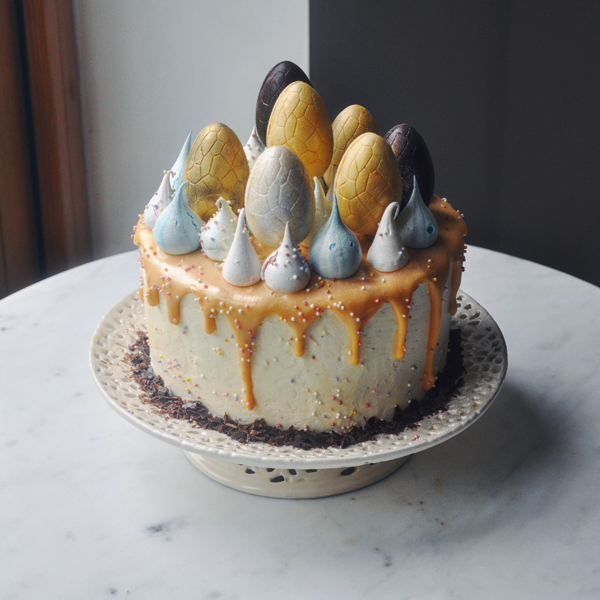
Making actual, proper cakes is something I don't do very often. You guys that do this day in day out are legendary; it's hard work!
A few weeks ago, I made a lemon version of this for Mother's day (are we really already at Easter?), so I thought I'd do it again with an Easter twist. I've provided a list of alternative ingredients at the bottom incase you want to make the lemon version instead.
Ingredients (Makes 1 individual cake, serving 8 people with lots of meringues left for the chef)
For the cakes (you'll need to make 2 and split them both)
- 350g Self-raising flour
- 350g Unsalted butter
- 350g Golden caster sugar
- 6 Whole large eggs
- 10g Baking powder (about 2 teaspoons)
- 10g Mixed spice (about 2 teaspoons)
For the white chocolate pistachio ganache
- 100g Shelled green pistachios or 2 tablespoons of pistachio butter
- 300g Whipping cream
- 300g White chocolate coverture (chips or callets if possible - this is what I'm using at the moment)
For the almond buttercream
- 120g Egg whites
- 200g Caster sugar
- 250g Unsalted butter
- 1 teaspoon of a strong almond extract
For the white chocolate drip ganache
- 150g Whipping cream
- 130g White chocolate coverture
- 20g Cocoa butter
- Paste or powder food colouring (I've used Wilton Ivory here)
For the meringues
- 75g egg whites
- 150g caster sugar
- Blue paste food colouring or any you feel like
Filled Eggs
For the tempered dark chocolate
- 250g Dark chocolate (at least 55% - this is what I've used here)
For the tempered white chocolate
- 250g White chocolate coverture
White chocolate passion fruit ganache filling
- 150g White chocolate coverture
- 150g Whipping cream
- 15g to 25g Passion fruit powder to your own taste (This one from Sous Chef is especially good)
Dark chocolate Manhattan ganache filling
- 150g Dark chocolate (at least 55%)
- 100g Whipping cream
- 30g Bourbon (I've used Four Roses Small Batch)
- 20g Sweet Vermouth (I've used Antica Formula)
- A few dashes of Angostura or other bitters
Other bits
- Gold and silver edible spray
- Dark rum for soaking into the cake layers
Equipment
- 18cm diameter, 8cm tall cake tin
- Plastic or other small egg mould
- Disposable piping bags and nozzles
- Silicone mat
- Stand mixer
- Sieve
- Stick blender
Make the cakes
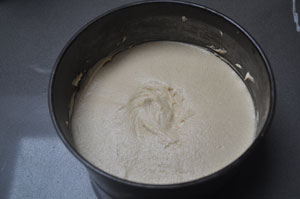
Pre-heat your oven to 170C, and line two (or one if you have to do it twice in the same tin like me) with baking parchment. Spray the insides of your tin and parchment with spray oil, cake spray or lightly butter the surfaces.
Place the butter in your stand mixer with the sugar and cream until the butter is soft. Sieve in the flour and baking powder, then add the eggs and mixed spice. Mix for a few minutes until you get a nice smooth mixture.
Pour half the mix into each cake tin, then level off with a spatula and bake for 35 to 40 minutes (until a chopstick inserted into the middle of the cake comes out clean).
Remove from the oven, and let cool for 10 minutes; then remove from the tins onto a wire rack and leave to cool completely.
Make the pistachio ganache (for both inside the cakes and one of the filled eggs)
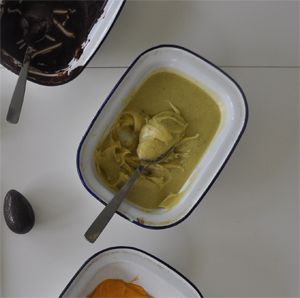
If you're using shop-bought pistachio butter, skip this first section.
Pre-heat your oven to 200C, then spread the pistachios out on a tray and toast for 10 minutes
Pour the nuts into a food processor, and blend for 10 minutes until the oils are released and the nuts turn into butter
Place the double cream in a heavy bottomed pot with around two tablespoons of the pistachio butter and mix with a spatula until combined.
Put the while chocolate into a heat-proof bowl (and chop if you're not using callets).
Heat the cream gently until it starts to bubble, then immediately pour over the white chocolate. Leave it for two or three minutes, then blend with your stick blender until all the white chocolate has melted. Finally, and it should still be warm at this point, add the unsalted butter and blend again.
Pour into a tray, cover with cling film and let set in the fridge for an hour.
Make the passion fruit ganache (for inside one type of filled eggs)
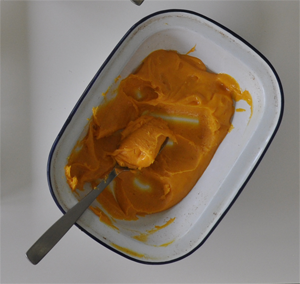
Place the double cream in a heavy bottomed pot and add the passion fruit powder. Stir to combine (note - you can use fresh passion fruit juice here, but it's just not as intense. If you use it, reduce the amount of cream by the weight of juice used)
Put the white chocolate into a heat-proof bowl (and chop if you're not using callets).
Heat the cream gently until it starts to bubble, then immediately pour over the white chocolate. Leave it for two or three minutes, then blend with your stick blender until all the white chocolate has melted. Finally, and it should still be warm at this point, add the unsalted butter and blend again.
Pour into a tray, cover with cling film and let set in the fridge for an hour.
Make the Manhattan ganache (for inside one type of filled eggs)

Place the double cream in a heavy bottomed pot with the vermouth, bourbon and bitters. Stir to combine.
Put the dark chocolate into a heat-proof bowl (and chop if you're not using callets).
Heat the cream gently until it starts to bubble, then immediately pour over the dark chocolate. Leave it for two or three minutes, then blend with your stick blender until all the chocolate has melted. Finally, and it should still be warm at this point, add the unsalted butter and blend again.
Pour into a tray, cover with cling film and let set in the fridge for an hour.
Temper and make the dark chocolate shells

Prepare a pot of water and place a heatproof bowl over the top. Weigh out your chocolate, then place two thirds into the heatproof bowl and reserve the rest.
Using a thermometer, heat and stir the chocolate until it reads between 45C and 50C.
Immediately remove from the heat, and mix in the remaining third of chocolate (chopped or callets) and stir vigorously until mixed. As you're doing this, take occasional temperature readings - when it hits 31 to 32C it's ready to use. If you dip below, very gently heat again over the bain marie - but don't exceed this temperature. If you're struggling to make the last third of the chocolate melt, use a stick blender to help.
When the chocolate is ready, pour it into the shell mould so that it fills them entirely - the amount given in this recipe is for the type of mould I'm using - you may need more or less.
This part all proper chocolatiers will want to collectively punch me in the face for - place your mould into the freezer for 60 seconds. This will help firm the outside of the chocolate shell.
When time is up, remove and pour the excess chocolate out, leaving a layer of around 5 or 6mm around the outside. Place back into the freezer for 5 minutes.
This time your chocolate should be completely solid - so scrape the edges of the mould with a sharp knife to release the shells (keep any shavings for decoration at the end of the cake), then flip the mould and tap hard on your work surface. If you've got a good temper (the chocolate, not your own demeanour) they should fall straight out. You may need to tap or drop the mould a few times to release them all. Reserve the shells for the next stage.
Temper and make the white chocolate shells
Follow exactly the same process above, except that you should wait until the temperature is 28 to 29C until pouring it into the mould.
Fill the shells
Remove the ganaches from the fridge, and spoon the Manhattan one into the dark shells. Smoothen with a spatula, but leave a little extra over the shell's edge. Press two halves together until some of the ganache leaks out, then take a paper towel and rub the excess off around the edge so that the shells stick together.
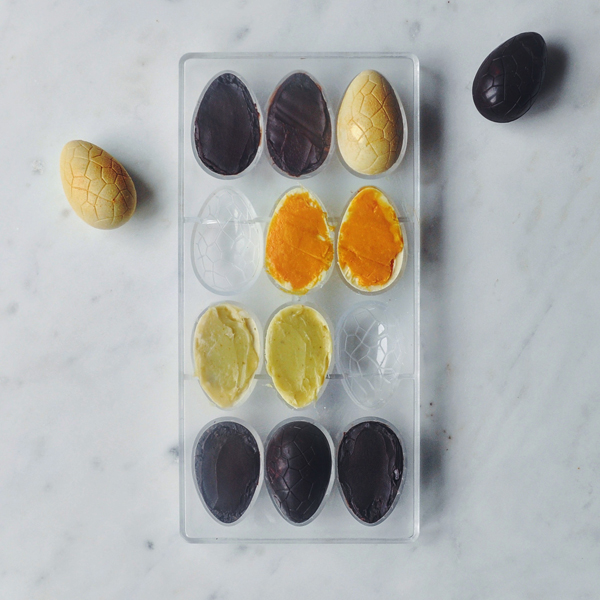
Repeat with the pistachio and passion fruit ganaches - you can mix and match these two between dark and white chocolate if you like; the Manhattan one only works well in the dark shells though!
Reserve the eggs in the fridge
Split and layer up the cake
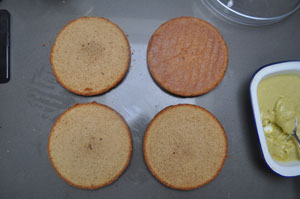
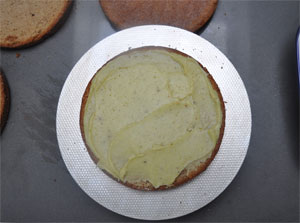
Take each of the two cakes, then cut the top off so that you have an even top and bottom. Split each of these in two, so you end up with 4 pieces of equal height.
Use the bottom of one cooked cake as the base, and the bottom of the other cooked cake as the top so you can really ensure a decent flat surface.
Place your first layer on a board or cake stand, then pour 3 tablespoons of dark rum over the surface as evenly as you can.
Spread around two tablespoons of the pistachio ganache over the cake, then level it up. Repeat with another two layers, then finally place the last layer over the top so you have a 4 layer cake with 3 layers of ganache sandwiched between. Place sin the fridge to firm up.
Make the meringues
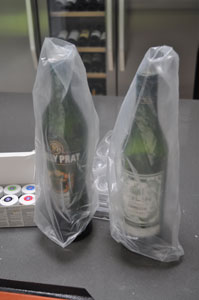
This is the brilliant Meringue Girls technique, which gives a chewy and delicious result.
Heat your oven to 200C, then place the caster sugar into a try lined with baking paper for 7 minutes.
When time's up, reduce your oven 100C.
Place the egg whites in the bowl of your stand mixer and whisk until firm peaks form. Gradually shower in the heated sugar, then keep whisking until the meringue is glossy.
Prepare a tray with a silicone mat, and piping bag with the food colouring - you want to take your piping bag, then turn it inside out, except for a tiny bit where you'll put the piping nozzle. Place this over a tall bottle, then grab your food colouring paste and paint 4 evenly spaced vertical lines from the top to the bottom of the bag. Remove from the bottle, place your piping nozzle in, and invert back the other way.
Fill the piping bag with your meringue, then pat it down with your hands to both remove the excess air and also get the colouring going. Tie, fold or clip the top then cut open the end and push out the nozzle.
Pipe evenly spaced meringues onto the silicone mat, pulling upwards to get a taller meringue. Leave a centimetre or two between each one.
Place in the oven for around 40 minutes
Make the drip ganache
Do this first, as it needs to thicken to exactly the correct consistency, and that can take some time.
Place the cream in a heavy bottomed pot. Weigh the chocolate and cocoa butter into a heat-proof bowl.
Heat the cream until it's bubbling, then pour onto the chocolate. Leave to stand for 2 or 3 minutes, then mix with a spatula or blend with a stick blender. Drop in the paste - I've used Wilton's Ivory colour here. Once completely combined, place in the freezer to firm up.
This is the trickiest part of the recipe; if you've not left it long enough, the ganache will be too runny and simply drip off the cake leaving a mess. If it's too thick it won't drip at all. You want it to be relatively heavy, and closer to fully setting than being liquid. It can take a couple of hours in the freezer - so wait it out, but check regularly. Get on with the buttercream while you're waiting.
Make the buttercream and ice the base cake
Place a pot of water on your hob, and heat until simmering. Weigh the egg whites and sugar into a bowl, then place this over the simmering water. Immediately start to whisk - and I'd recommend a hand-held electric whisk at this point. Keep going until it whips to a stiff peak.
Transfer to your stand mixer bowl, and whisk again. While it's still hot, start dropping the butter in piece by piece until it's all gone. The heat will melt the butter, so it won't cream straight away - but give it 5 or 10 minutes at high speed and you'll end up with a smooth buttercream. Before you stop whisking, add the almond essence.
Finally, ice the cake by plastering the outside and top with buttercream, then placing back in the fridge for 20 minutes. When time's up, remove the cake from the fridge and you'll find the buttercream has firmed up slightly. Begin to smoothen the sides and top with a long spatula. If you've got one of those rotating cake stands, use that by placing the spatula up against the cake and spinning the base instead. You can keep dipping your spatula into warm water if you want to make it really smooth. The top is less important to get totally perfect, as the ganache will cover any minor imperfections.
Place back in the fridge until the drip ganache is ready.
Drip the ganache
When the ganache is just about moving when you spoon it, it's ready. Start to spoon small amounts near the edge; if it starts to drip down the cake all the way to the bottom, it's still not firm enough - so return to the freezer. If it starts to drip and stops somewhere down the buttercream, you're good.
Continue doing this all around the cake using more or less each time so the drips are different lengths.
When you've gone all the way around, use the remaining ganache to fill the top of the cake, then place in the fridge to solidify one last time
To serve
Place a toothpick into the bottom of each egg you're adding to the cake. If you've got / are using gold and silver edible spray, spray them at this stage. Stick 6 or 7 eggs on top at different heights.
Place some meringues around randomly, then finally throw over some hundreds and thousands.
If you kept any of the chocolate scrapings, place these around the bottom of the cake.
Hope you enjoy this one and Happy Easter!
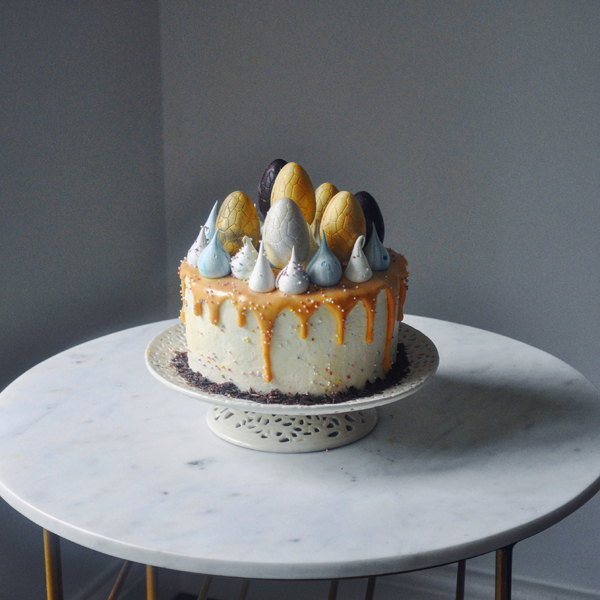
Lemon variation
- Substitute the mixed spice for the zest of two lemons and the juice of half in the cake mix
- When layering, substitute the rum for gin mixed with lemon juice
- When making the buttercream, substitute the almond essence for more lemon zest and a 1/2 teaspoon of vanilla powder or extract
- Instead of the pistachio ganache between the cakes, make or buy lemon curd and spread between each layer. Here's my recipe from way back in post #2
- Instead of the filled eggs, make some lemon macarons filled with curd and whipped cream. Here's one receipe for the shells from post #19
- Substitute out the random colours for yellow!

Vanilla
Inspired by the Philippe Conticini classic from LPDR
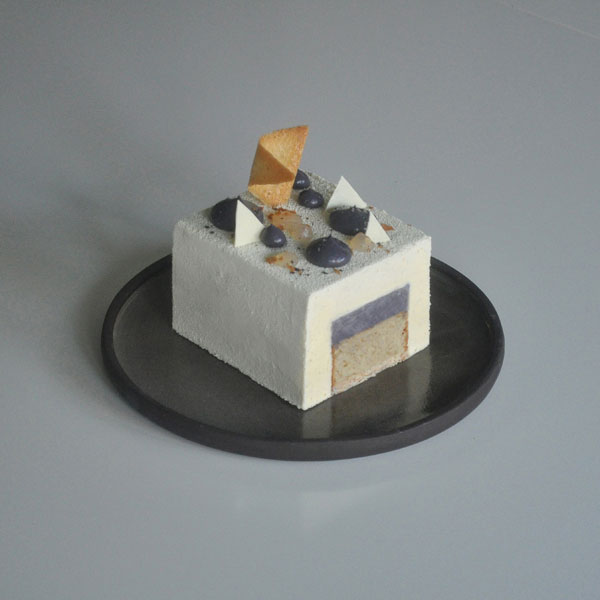
Grand Cru Vanille. Grand. Cru. Vanille.
If you've ever been to La Pâtisserie des Rêves in London or Paris you'll know what I mean. It's a completely unassuming cake, which you'd perhaps not look twice at given the treats under the cloches ... then you try it and you realise (as long as you actually like vanilla) that it's one of the greatest pieces of pâtisserie ever made. The real recipe, however, is notably absent from the LPDR book - probably because it's a closely guarded secret.
I've wanted to recreate it for years, and have commented many times to my Instagram buddy and pâtisserie genius Alvin about attempting it.
While re-creating it would be cool, I thought - you know, since LPDR's version is actually perfect - that wouldn't be wise as it would only cause disappointment. So, instead, I've re-imagined it. A bit.
I made this one for my mum's 72nd Birthday this week. The whole cake was polished off; good job the recipe makes two.
You can reduce the complexity by omitting the decorations if you prefer. My preference was to use a Silverwood adjustable cake tin for this (link in the ingredients section below) but you can easily adapt it if you have two 30cm tins that fit inside each other.
Ingredients (Makes 2 individual cakes, each serving 4 people. You'll also have left over salted tuilles and Feuilletine chocolate pieces to enjoy later)
For the Joconde layer
- 62g icing sugar
- 63g ground almonds
- 20g strong flour
- 80g whole eggs
- 14g unsalted butter
- 50g egg whites
- 15g caster sugar
- Optional - 100% proof vodka with a vanilla pod soaked inside for 2 weeks
For the Feuilletine layer
- 95g ground almonds
- 15g icing sugar
- 7g unsalted butter
- 60g white chocolate couverture
- 1/2 tsp fleur de sel
- 1 Vanilla pod
- 1/2 tsp Vanilla powder
- 35g feuilletine
For the black vanilla bavaroise
- 125g white chocolate couverture
- 125g full fat milk
- 30g egg yolks
- 15g caster sugar
- 190g whipping cream
- 3g gelatine (about 1 1/2 sheets)
- 1 tsp Vanilla powder
- 2 vanilla pods
- 1tsp black food colouring or activated charcoal
For the white vanilla bavaroise
- 250g white chocolate couverture
- 250g full fat milk
- 60g egg yolks
- 30g caster sugar
- 380g whipping cream
- 6g gelatine (about 1 1/2 sheets)
- 2 vanilla pods
For the white chocolate flocking
- 200g white chocolate couverture
- 140g cocoa butter
- 4 teaspoons of superwhite food whitener (optional)
For the fleur de sel tuiles (optional)
- 25g unsalted butter
- 40g egg white
- 55g caster sugar
- 25g double zero flour
- Pinch of vanilla powder
- Several pinches of fleur de sel
For the vanilla vodka fluid gel (optional)
- 110g soda water
- 25g caster sugar
- 15g vanilla vodka (I used 100% proof Stoli with a vanilla pod soaked inside for 2 weeks)
- 1/4 tsp vanilla powder
- 2g agar agar
To serve
- Vanilla powder
- Fleur de sel
- Feuilletine
Equipment required
- Cake frame with adjustable panels (Silverwood does a good one)
- Thermometer
- Piping bags and nozzles for plating
- Silicone mat
- Stand mixer
- Food processor
- Sieve
- Stick blender
- Spray gun
Make the Feuilletine layer
Put the ground almonds and icing sugar in your food processor and leave running until the oils of the nuts begin to be released and you get an almond paste. This will take around 10 minutes.Split and scrape out the seeds from the vanilla pod and put these, the split pod, vanilla powder, salt, butter and white chocolate into a heatproof bowl and melt over a simmering pot of water.
When completely melted, remove the pod and combine with the ground almond paste.
Fold in the feuilletine, then pour out onto some cling film. Cover with a second layer of cling, then push down with a rolling pin - it should be thick enough to roll out, but leave to cool a little if it's too soft.
Roll out to about 1/4 cm thick - it should be at least 30cm long, and 5 to 6 cm wide (see next section). Place in the fridge while you continue.
Make the Joconde
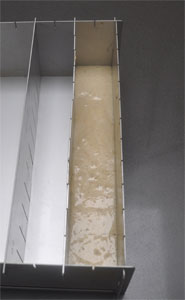 Pre-heat your oven to 200°C.
Pre-heat your oven to 200°C.
Prepare your tin - if you've got a silverwood, you want to set it so you have it set at 2 notches wide, as shown here to the right. If not, a tray tha'ts 5 to 6 cm wide by 30 cm long will do. Spray it with bake spray, and line the bottom with greaseproof paper.
Put the eggs, icing sugar, flour and ground almonds in the bowl of your stand mixer, and whip up with the whisk attachment for about 10 minutes.
While this is running, melt the butter then let it cool. After 10 minutes are up, slowly pour the butter into the running mixer.
Put the egg whites into a clean bowl, and whip until medium firm. Shower in the caster sugar, then whip to stiff peaks.
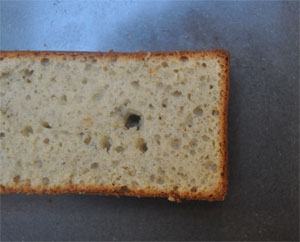
Gently fold the egg whites into the flour mix, then pour this into your tin.
Bake for 15 minutes until golden and a skewer / chopstick comes out clean.
Leave to cool, then trim off the top so you end up with an exposed sponge. It should be 3 to 4cm in height after being cut. Flip it upside down, so the exposed sponge is on the bottom.
Remove the feuilletine layer from the fridge (still in the cling film), then put the joconde on top. Cut the feuilletine so that it matches the sponge as closely as possible - we'll be chopping the ends off later, so it's the sides that matter the most.
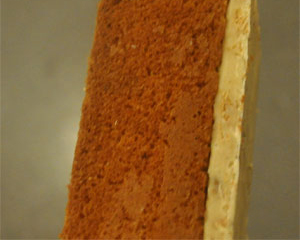 Peel off the top layer of cling then place this back in your 5cm x 30cm baking tin with the cling film layer at the bottom so it's easier to remove later (get that right or you'll end up with cling inside your cake!).
Peel off the top layer of cling then place this back in your 5cm x 30cm baking tin with the cling film layer at the bottom so it's easier to remove later (get that right or you'll end up with cling inside your cake!).
Place the joconde on top, cut side down onto the feuilletine. If using the vanilla vodka, brush some on top of the sponge. Put this in your freezer.
Make the black vanilla bavaroise
Weigh your milk out into a heavy bottomed pan, then split and scrape the vanilla pods to get the seeds. Add both the seeds and pods to the milk along with the extra vanilla powder.Heat until it hits boiling point, then turn off your cooker hob ring and leave to infuse for 30 minutes.
When time's nearly up, start preparing the other ingredients. Soak your gelatine in cold water and set aside.
Weigh out the white chocolate into another bowl with a fine sieve on top, and again set aside.
In a 3rd bowl, place the egg yolks and whisk them with the caster sugar until they become pale. Finally, get your thermometer ready.
Remove the pods from the milk, then put over a medium heat until boiling again. Carefully temper the egg yolks by pouring a little milk over them while whisking. Continue to add more until all the milk has been combined with the yolks.
Pour this back into the pan and keep stirring with a wooden spoon. Read the temperature - raise it until the thermometer reads 82 degrees C then immediately pour through the sieve onto the chocolate. Let this sit for a few minutes, then squeeze out the gelatine and add to the mix. Use a stick blender to blend everything to ensure it's totally smooth.
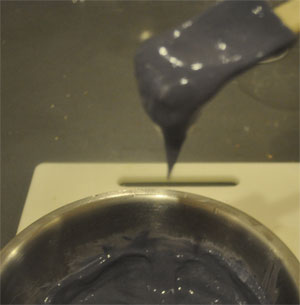 Start adding the black food colouring - my one turned out purple-ish (using Americolor powder) but that's probably because I didn't want to overdo it. Go as hard as you like.
Start adding the black food colouring - my one turned out purple-ish (using Americolor powder) but that's probably because I didn't want to overdo it. Go as hard as you like.
When you're happy it's all blended, pass through a sieve once more into a clean bowl and set aside in the freezer for 10 minutes to firm up.
Remove from the freezer, and whip the cream until quite thick - enough to hold its shape for a few seconds if you drop some from a spoon. Fold the cream into the custard, and return to the freezer for another 10 minutes.
After time's up, the bavaroise should be quite thick - dropping consistency as shown to the right. If it's not thick enough, freeze for a bit longer.
If you're happy, pour it over the joconde to about 1cm in height (you'll have some left over for the top) and tap the frame to level it out. Place back in the freezer to completely firm up (at least an hour). Put the remaining bavaroise in a piping bag with a 1cm nozzle and reserve in the fridge.
Make the white vanilla bavaroise
This is the same method as above, but wait until the black layer has set before you start. While it may seem like a lot, you'll need it to cover everything.Weigh your milk out into a heavy bottomed pan, then split and scrape the vanilla pods to get the seeds. Add both the seeds and pods to the milk. No extra powder in this one.
Heat until it hits boiling point, then turn off your cooker hob ring and leave to infuse for 30 minutes.
When time's nearly up, start preparing the other ingredients. Soak your gelatine in cold water and set aside.
Weigh out the white chocolate into another bowl with a fine sieve on top, and again set aside.
In a 3rd bowl, place the egg yolks and whisk them with the caster sugar until they become pale. Finally, get your thermometer ready.
Remove the pods from the milk, then put over a medium heat until boiling again. Carefully temper the egg yolks by pouring a little milk over them while whisking. Continue to add more until all the milk has been combined with the yolks.
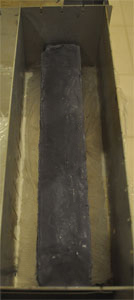 Pour this back into the pan and keep stirring with a wooden spoon. Read the temperature - raise it until the thermometer reads 82 degrees C then immediately pour through the sieve onto the chocolate. Let this sit for a few minutes, then squeeze out the gelatine and add to the mix. Use a stick blender to blend everything to ensure it's totally smooth.
Pour this back into the pan and keep stirring with a wooden spoon. Read the temperature - raise it until the thermometer reads 82 degrees C then immediately pour through the sieve onto the chocolate. Let this sit for a few minutes, then squeeze out the gelatine and add to the mix. Use a stick blender to blend everything to ensure it's totally smooth.
When you're happy it's all blended, pass through a sieve once more into a clean bowl and set aside in the freezer for 10 minutes to firm up.
Remove from the freezer, and whip the cream until quite thick - enough to hold its shape for a few seconds if you drop some from a spoon. Fold the cream into the custard, and return to the freezer for another 10 minutes.
After time's up, the bavaroise should be quite thick - dropping consistency as shown in the image of the black bavaroise above. If it's not thick enough, freeze for a bit longer.
Next, if using the Silverwood cake tin, change the notches so you have 3 showing (i.e. 4 lanes wide). Move the frozen 3-layer cake to the centre as best you can (we'll trim it later anyway). Otherwise, put your frozen cake in the larger of your two tins. Line the sides of the tin with greaseproof paper, cling or acetate.
Pour the mix over the frozen cake, making sure it goes down each side, and tap the frame to level it out. Place back in the freezer to completely firm up (at least 2 hours this time).
Spray
Put the chocolate, cocoa butter and superwhite (if using) in a heatproof bowl and place over a simmering pot of water.When everything looks completely melted, blend with your stick blender just in case then pour into your spray gun.
Take out a big box - a 12-hole wine box is a good size, or one for 12" vinyl records (a sentence which sums up our household quite neatly) - and cut off top flap. Lay it down so you have flaps on the left, bottom and right. Place a chopping board in the box, then put a layer of greaseproof paper on top.
Remove the cake from the freezer. At this point, we need to cut the cake in half. You're welcome to keep it whole, but I found this to be much easier to spray.
If the sides are a bit wonky (mine were, as I'd used cling film and didn't get the cake dead-centre) use a very sharp knife to cut thin slides from each side to level things up.
If necessary, you can also use a blowtorch to slightly melt (heat for no more than 1/2 second) any side that isn't perfectly smooth. Once heated, use a right-angled spatula to smoothen. It should re-freeze within a couple of seconds.
If you're ready to spray, put your first cake in the box and turn on the gun. When flocking, I normally rotate the cake 3 times to make sure it has built up enough.
Repeat with the other cake, then return to the freezer to harden.
If you like, any remaining chocolate can be spread on a silicone mat to harden up. You can then use shards of it to decorate the cake later.
Make the tuiles (optional)
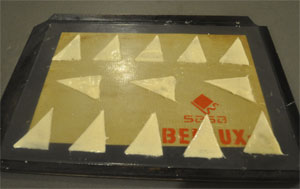 Pre-heat your oven to 170°C.
Pre-heat your oven to 170°C.
Heat the butter in a pot, then remove from the hob and let it cool a little.
Place the egg whites and caster sugar in a bowl and whisk until combined. Add the vanilla powder and whisk again. Finally, sieve in the flour, and whisk until you get a paste. Pour in the cooled butter and make one final whisk to combine.
Place a silicone baking mat on a heavy tray.
If you've got a tuile pattern mould, put it over the silicone mat. I don't - so I've made a triangle one by cutting one out of a piece of acetate.
Spoon a small amount of batter onto the mould or template, then use a pallete knife to smothen. They should be around 2mm thick. If you don't have a mould or template, just spoon some onto the mat and make a circle with the back of the spoon. Sprinkle each one with a small amount of fleur de sel.
Place in the oven for 7 minutes.
Get a rolling pin ready to bend the tuiles - or in my case, I had one of those U-shaped moulds. These produce a really good bend. In either case, remove the tray from the oven, and use a palette knife to release the tuiles. Place them carefully over the pin or in the U-shaped mould - the first ones will be quite pliable, but as you reach the end of the tray you might find them becoming brittle. Try to work as quickly as you can.
Leave to cool.
Make the fluid gel (optional)
Weigh the soda, sugar, vanilla powder and agar agar into a heavy bottomed pot. Heat until it boils, while whisking constantly.When it hits boiling point, remove from the heat and pour into a bowl. Leave it to cool slightly, then add the vodka.
It will set after around 30 minutes at room temperature. To make the gel, simply remove the set jelly, chop it and throw it in your blender for 5 minutes. The agar structure will break down, but remain viscous.
Slide into a piping bag with a 1/4cm nozzle.
Plating up
Take the sprayed cakes out of the freezer. On the first cake, using a sharp knife, slice off each end so that it exposes the layers within again.Pipe dots of the black custard in random sizes on top, followed by dots of fluid gel. Add one of the salted tuiles, sticking it into the cake gently. Crumble over some feuilletine, dust a tiny bit of vanilla powder over the top and add a few crystals of fleur de sel. Finally add your chocolate shards, if using.
Repeat with the second cake.
At this point you'll want to let it defrost a bit more at room temperature - due to everything being really soft, it won't take long. If your house is reasonably warm, it'll be done in 30 mins to an hour.
When you slice it, blowtorch or otherwise heat your knife firsts. Cut quite thin slices - about 1cm thick.
Enjoy all your hard work. Or, if it has all gone wrong, pop down to LPDR and buy a Grand Cru Vanille. It might just change your life.
Matchnberg
Matcha, vanilla and cashew Battenberg
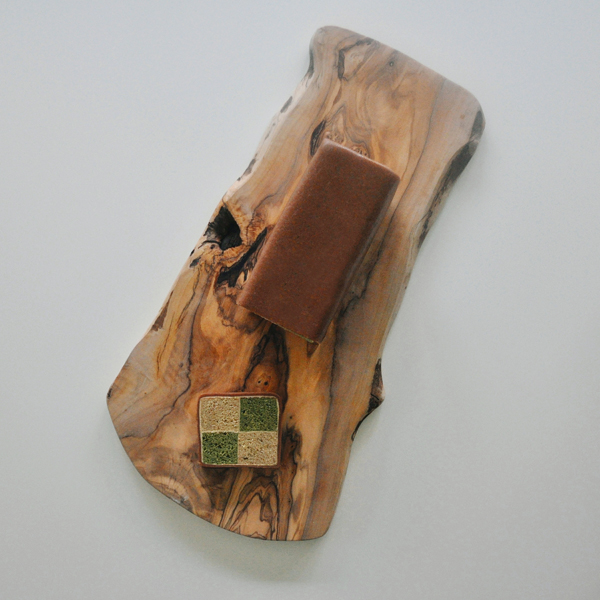
I'm training for an off-road marathon at the moment (yes, more fool me) - so naturally tea & cake are on my mind after a long run.
I had a lot of love for Mr. Kipling's mini Battengerg cakes; the kind of thing I'd demolish when coming in from DJ'ing at 3am as a teenager. I'd still do a whole pack now to be honest, even if they are sickly sweet.
I've tried to create a different version of the classic Battenberg, bringing in a more savoury flavour with matcha and some cashew to give the cake a more interesting flavour.
You'll have some cashew butter left over at the end - stick some in your morning porridge while it cooks.
Makes 1 cake (and some extra cashew butter)
Ingredients
For cocoa marzipan
- 250g ground almond
- 175g caster sugar
- 150g icing sugar
- 15g cocoa powder
- 1 whole large egg
- 1 large egg yolk
- Splash of water if needed
For the matcha sponge
- 140g self-raising flour
- 15g matcha tea
- 40g ground almonds
- 175g caster sugar
- 175g unsalted butter
- 3 large eggs
- 2g fine salt
- 2g baking powder
For the vanilla sponge
- 140g self-raising flour
- 50g ground almonds
- 175g caster sugar
- 175g unsalted butter
- 3 large eggs
- 2g vanilla powder or strong vanilla essence
- 2g baking powder
For the cashew butter
- 200g salted and roasted cashew nuts
- 20g maple syrup
- 15g coconut oil (solid or liquid state)
For the cashew buttercream
- 125g of the cashew butter
- 55g unsalted butter
- 125 icing sugar
- Splash of milk
Equipment
- Stand mixer
- Cake tin - ideally a multi-size tin with moveable walls (Alan Silverwood make a good one) or if not, two 20 x 20 cm tins
- Food processor or blender
Marzipan
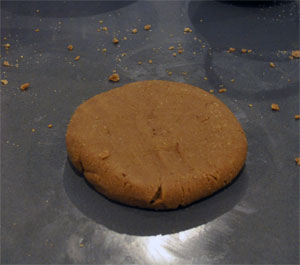 Combine all the dry ingredients together in a large bowl, starting with the icing sugar (so it sits at the bottom and doesn't fly everywhere during the mixing). Briefly whisk the whole egg and egg yolk, then make a well in the sugars and pour it in. Bring the whole lot together with your hands; it will take some time, and you'll get messy, but the marzipan will come together in the end. Keep pressing or kneading it down so that the moisture is all absorbed and you get a smooth sweet pastry-like texture. If it looks too dry, just add a splash of water.
Combine all the dry ingredients together in a large bowl, starting with the icing sugar (so it sits at the bottom and doesn't fly everywhere during the mixing). Briefly whisk the whole egg and egg yolk, then make a well in the sugars and pour it in. Bring the whole lot together with your hands; it will take some time, and you'll get messy, but the marzipan will come together in the end. Keep pressing or kneading it down so that the moisture is all absorbed and you get a smooth sweet pastry-like texture. If it looks too dry, just add a splash of water.
Matcha cake
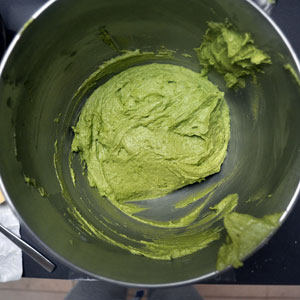 If you're using an Alan Silverwood tin, Move the walls to give you two 3 x notch section widths. Line your cake tin with baking paper sprayed with a little bake easy or coconut oil spray, then pre-heat the oven to 160 degrees C.
If you're using an Alan Silverwood tin, Move the walls to give you two 3 x notch section widths. Line your cake tin with baking paper sprayed with a little bake easy or coconut oil spray, then pre-heat the oven to 160 degrees C.
Place the butter, sugar, flour, matcha, almond, salt and baking powder in the bowl of a stand mixer with the beater attachment in place. Beat on a low speed initially, then speed it up as the butter starts to combine. Crack in your 3 eggs then let the whole lot mix on a medium speed for a few minutes until everything is smooth.
Spoon this into one of your lined tins or one section of a multi-size tin. Smooth the top so that it looks as even as possible - the mix is thick, so you can't really tap it down; try to do it by eye with a flat spatula.
Immediately clean & dry your stand mixer bowl, then move to the next stage
Vanilla cake
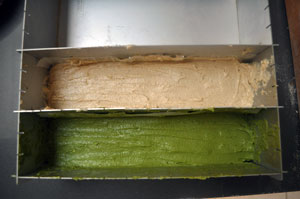 The process is identical, swapping out the slightly different measurements and vanilla for matcha.
The process is identical, swapping out the slightly different measurements and vanilla for matcha.
Place the butter, sugar, flour, vanilla powder, almond and baking powder in the bowl of a stand mixer with the beater attachment in place. Beat on a low speed initially, then speed it up as the butter starts to combine. Crack in your 3 eggs then let the whole lot mix on a medium speed for a few minutes until everything is smooth.
Spoon this into the other of your lined tins or the second section of a multi-size tin. Again, smooth the top by eye.
Place both tins or the single tin in your oven, and bake for 35 minutes. When a chopstick inserted in into the very centre comes out clean remove the cakes from the oven - then leave to cool completely while you make the butter.
Cashew butter
Put the cashews in your food processor or blender, and leave to blend for around 5 minutes. You might need to give it the occasional shake or open the lid and scrape down the sides. After becoming a powder, the cashews will eventually begin to release their oil and become a kind of paste. When this starts to happen, add the maple syrup, coconut oil and continue to blend until it has a smooth but solid structure.
If there is any excess oil in the bowl, try to drain it away - or, if there's a lot, put the butter in a muslin cloth and squeeze any extra oil out. Reserve the butter for the next step.
Cashew buttercream
Weigh out 125g of the cashew butter, then and that and the unsalted butter to the bowl of your stand mixer. Beat on high with the beater attachment for a number of minutes until the butters are combined and fluffy. Add the icing sugar in several stages, beating slowly first, then on high again until each portion of sugar is combined. If the buttercream looks too solid, splash in some milk and beat again.
Once you have a light, spreadable buttercream, move to the next stage.
Assembly
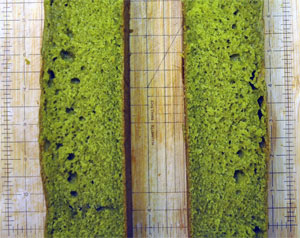 Peel the baking paper from your cooled cakes.
Peel the baking paper from your cooled cakes.
Take the matcha cake first. Measure and mark the centre point on both ends, then cut down the centre as evenly as you can. Next, turn the cake so that the freshly cut face is on top. On one cake, closely slice off the cooked top and bottom, then measure what's left. Mark and measure the second half of the cake, and make the same two cuts.
Finally, measure the distance between the two sides you've just cut. Turn the cake once more so that it reveals the final cooked section. Mark out the distance you've just measured and trim the cooked side away. Repeat with the other half of the cake, and this should leave you with two perfectly cut pieces of the same size. If there are any imperfections, place the cakes side by side and gradually shave a sharp kitchen knife over the top so that they match.
Repeat this process with the vanilla cake.
Take a large sheet of cling film and place it on your biggest work surface, then take the marzipan and drop that in the centre. Place a second sheet of cling film over the first, sandwiching the marzipan in the middle. Begin to roll it out, trying to make a large rectangle with its edges as wide as the edge of the cling sheet - trim off any excess so you get a clean line, but keep spare marzipan for filling any holes on the underside. The thickness should be no more than about 2mm at all points. When you're happy, peel off the top layer of cling film.
With a large angled spatula, spread a thin layer of cashew buttercream over the rolled out marzipan, then another on one side of one of the matcha cakes. Use the spatula to move one of the matcha cake over, then one of the vanilla cakes so that they are side by side in the very centre of the marzipan rectangle with the buttercream between them.
Next, spread another thin layer of buttercream over the top of the two cakes that are on the marzipan, and then again on one side of the next matcha cake that's yet to be brought over.
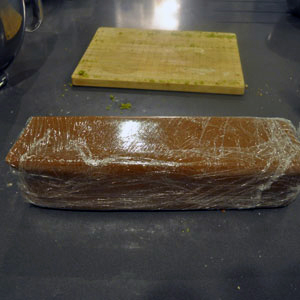 Move the vanilla cake over first this time, then the final matcha cake so that they alternate.
Move the vanilla cake over first this time, then the final matcha cake so that they alternate.
Almost there - carefully pull one side of the marzipan up and over so that it covers the side furthest away from you and then comes up to around half the cake. Repeat with the other side - with any luck, you'll have a perfect join. If you've got too much marzipan then trim some away and try again. If there's not enough, pull them as closely as you can and use any trimmed pieces to fill the gap
Smoothen the marzipan around the cake with your hands, taking care not to dent it. Finally, wrap the whole thing in another sheet of cling so it's all tight, then invert so the seam is on the bottom. Place in your fridge for at least 30 minutes.
After it has cooled down, use a kitchen knife to slice both ends off so that you get a clean finish. The cake can now sit outside the fridge and come to room temperature, ready for eating.









